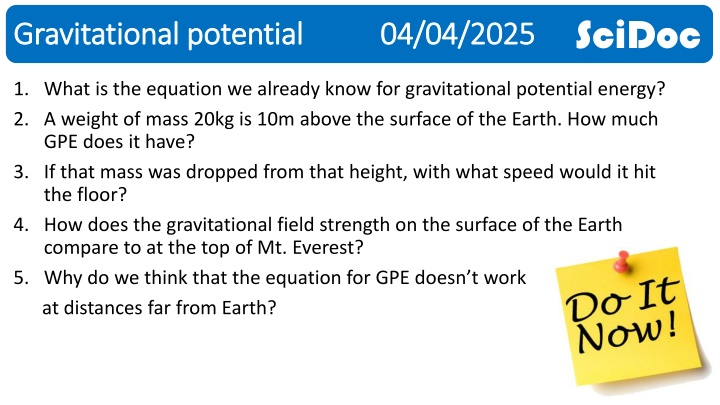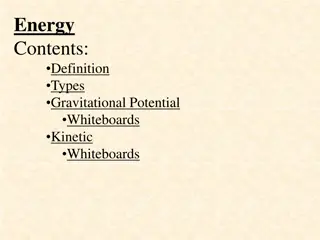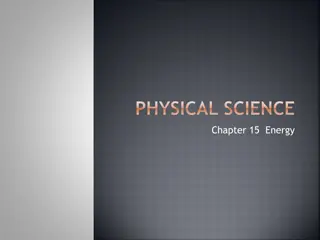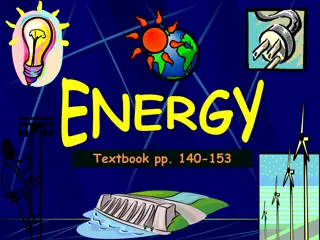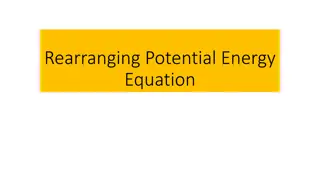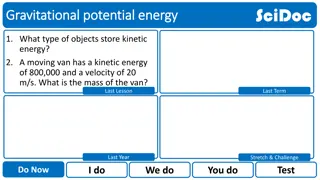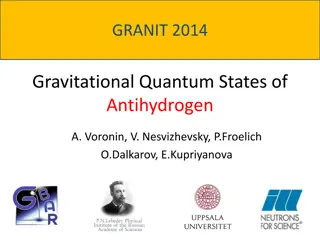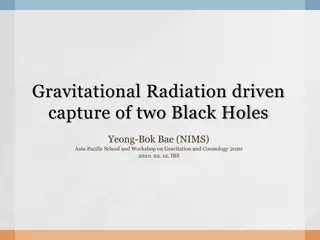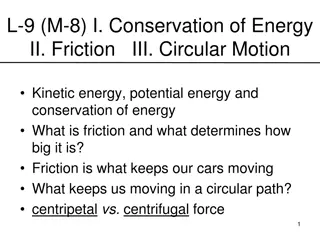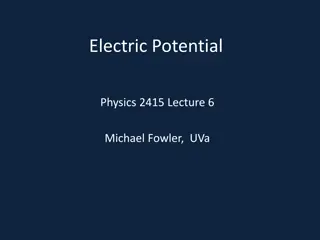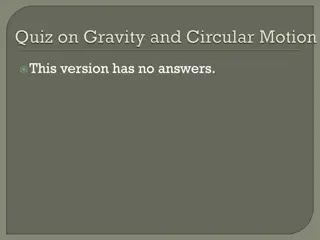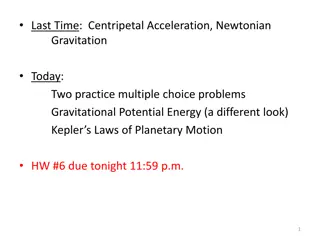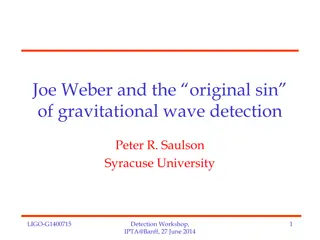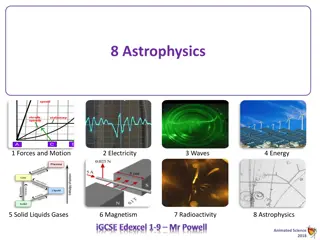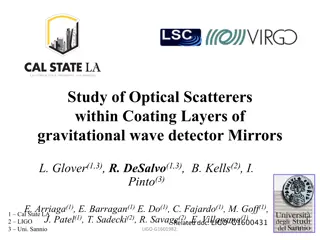Gravitational Potential Energy
Gravitational potential energy is the energy an object possesses due to its position in a gravitational field. It is defined by the work done per unit mass in moving an object from infinity to a specific point. This energy plays a crucial role in understanding the behavior of objects subject to gravity, such as calculating potential energy at different heights, determining escape velocities, and exploring equipotentials and potential gradients in gravitational fields.
Download Presentation

Please find below an Image/Link to download the presentation.
The content on the website is provided AS IS for your information and personal use only. It may not be sold, licensed, or shared on other websites without obtaining consent from the author.If you encounter any issues during the download, it is possible that the publisher has removed the file from their server.
You are allowed to download the files provided on this website for personal or commercial use, subject to the condition that they are used lawfully. All files are the property of their respective owners.
The content on the website is provided AS IS for your information and personal use only. It may not be sold, licensed, or shared on other websites without obtaining consent from the author.
E N D
Presentation Transcript
SciDoc Gravitational potential Gravitational potential 04/04/2025 04/04/2025 1. What is the equation we already know for gravitational potential energy? 2. A weight of mass 20kg is 10m above the surface of the Earth. How much GPE does it have? 3. If that mass was dropped from that height, with what speed would it hit the floor? 4. How does the gravitational field strength on the surface of the Earth compare to at the top of Mt. Everest? 5. Why do we think that the equation for GPE doesn t work at distances far from Earth?
SciDoc Gravitational potential energy Gravitational potential energy Gravitational potential energy is the energy of any object due to its position in a gravitational field. The position for zero GPE is at infinity (object is so far away that gravitational force on it is negligible).
SciDoc T/N: Gravitational Potential T/N: Gravitational Potential The gravitational potential, V, at a point is the work done per unit mass to move a small object from infinity to that point: ? =? ? where W is the work done (in J), and m is the mass (in kg). Stretch: A rocket has a mass of 1000 kg, and the gravitational potential of the planet is -100 MJ/kg. a) How much energy is required for the rocket to completely escape the gravitational field of the plant? b) What happens if the rocket is only given 40,000 MJ of KE from the fuel?
SciDoc Why is gravitational potential negative? Why is gravitational potential negative? The gravitational potential is negative because a negative amount of work is done to bring an object closer to the Earth. Stretch: What on Earth is a negative amount of work? We can t have a negative energy right?
SciDoc Equipotentials Equipotentials Equipotentials are surfaces of constant potential. No work needs to be done to move along an equipotential surface.
SciDoc Potential gradient Potential gradient The potential gradient at a point in a gravitational field is the change of potential per metre at that point. Near the Earth s surface the potential changes by 9.8 Jkg-1 for every metre of height gained. So the potential gradient near the surface of the Earth is constant and equal to 9.8 Jkg-1m-1. However, further from the Earth s surface, the potential gradient becomes less and less. Stretch: What therefore is the equation for potential gradient?
SciDoc Gravitational field strength Gravitational field strength Gravitational field strength g is the negative of the potential gradient: ? = ? ? Here, the minus sign shows you that g acts in the opposite direction to the potential gradient.
SciDoc Gravitational potential Gravitational potential Because ? = ? beyond the surface of a spherical planet, the gravitational potential V at a distance r from the centre of the planet of mass M is given by: ? = ?? ? at or ? Stretch: Derive this equation from Newton s law of gravitation.
SciDoc Moving an object Moving an object Moving an object from one position to another requires work to be done against the force of gravity. The amount of energy required depends on the mass of the object being moved and the gravitational potential difference that the mass moves through:
SciDoc Task Task Complete the questions.
SciDoc Answers Answers 1. The value for g is not constant for large changes in h; the Earth s field is a radial field and so for only small changes of h (or r) can the field be considered uniform 2. V = GM/R; J kg 1 3. 63MJkg-1; the potential is defined as zero at infinity and therefore becomes increasingly negative as it approaches Earth; work 4. It is the gradient of a V r graph at the point r, i.e. g = V/ r 5. lines along which a mass experiences no change in gravitational potential 6. They are always perpendicular 7. Zero 8. E= m(V2 V1) 9. -3.8 109 J/kg 10. 1.9 1027 kg 11. 25.7 N/kg 12. The satellite moves along an equipotential and there is thus no change in potential energy; as total energy is conserved, there is no change in kinetic energy, so speed remains constant 13. GPE = -GMm/r = (- 6.67 x 10-11x 6.0 x 1024x 60) / 6.4 x 106= - 3.8 x 109J 14. V = -GM/r = (-6.67 x 10-11 x 6.0 x 1024) / 6.4 x 106 = - 6.3 x 107 J kg-1 or - 63 MJ kg-1
SciDoc Answers Answers 15. V = -GM/r = (-6.67 x 10-11 x 6.0 x 1024) / (6.4 x 106 + 3.6 x 107) = -9.4 x 106 J kg-1 or -9.4 MJ kg-1 The potential difference is then - 9.4 (- 63) = 53 MJ kg-1 (or 5.3 x 107 J kg-1). 16. Well, we now know that the potential difference between the Earth s surface and the geostationary orbit height is + 5.3 x 107 J kg-1. In other words, for each kg of mass lifted from Earth to geostationary orbit, 5.3 x 107 J of energy is required. Therefore, for a satellite of mass 150 kg, energy required = 150 x 5.3 x 107= 8.0 x 109 J or (or 8.0 GJ). Actually, much more energy is required because there is drag with the Earth s atmosphere to overcome on the way up, and also the rocket itself (and its fuel) have mass that needs to be lifted into orbit too! The answer we ve arrived at is only the energy required to lift the satellite against the gravitational pull of the Earth. 16. For a uniform field, change in potential = gh = 9.8 x 50 = 490 J kg-1
SciDoc Exam question Exam question Complete the exam question.
